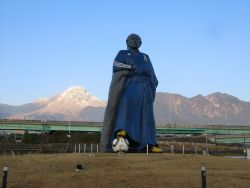
Originally published on metropolis.co.jp on May 2012

Blasts from the past
- The Ginza line unveiled retro train carriages painted lemon yellow and featuring “seats of a red brick design that remind passengers of building architecture common in the early Showa Period.”
- The Rose Hotel in Yokohama is reviving three recipes—including one for frog and seafood curry—that originally appeared in “the first translated books on Western cuisine,” way back in 1872.
- The race is on: two Japanese women, aged 72 and 73, are vying to become the oldest woman ever to climb Mt. Everest.
- An explosion at a glue factory in Yamaguchi killed one worker and injured 11 passersby with broken glass. It took firefighters 15 hours to extinguish the blaze.
Breakthroughs
- A paper written by a Japanese scientist at the University of Texas is being hailed as the most highly cited academic work of 2011. Which is not surprising when you consider the sexy title: “Seven-Year Wilkinson Microwave Anisotropy Probe Observations: Cosmological Interpretations.”
- Meanwhile, the Chinese Academy of Sciences has overtaken the University of Tokyo in terms of “research influence.”
- Kyoto University professor Shinya Yamanaka was awarded the Millennium Technology Prize by Technology Academy Finland for his work on stem cell research. The prize honors “researchers and engineers whose innovations have improved the quality of life.”
- Headline of the Week: “Kyoto University Researchers Reproduce Mouse from Freeze-dried Sperm” (via The Mainichi Daily News)
The Young Ones
- A 14-year-old boy was arrested for stabbing a bus driver at JR Nishi-Hachioji station. The assailant said he was lashing out after a friend made fun of him.
- A 19-year-old motorist in Nemuro, Hokkaido, swerved to avoid hitting a deer and collided with another car, killing both occupants of the oncoming vehicle.
- So long, seishain: according to a recent survey, nearly 60 percent of Japanese college students prefer to work at small or medium-size companies.
- A drunk Nigerian stabbed an 18-year-old Japanese boy in the neck with a broken beer bottle just before 8am near JR Shin-Koiwa station last month.
Foreign legion
- The foreign ministers of Japan and Cambodia agreed to boost “cooperation on disaster prevention, regional peace and youth exchange programs.” We’re assuming that last bit doesn’t involve salaryman sex junkets.
- Emperor Akihito seems to have recovered nicely from his recent heart surgery. In addition to meeting the PM’s of Thailand, Laos, Cambodia and Vietnam, as well as the president of Myanmar, he’s set to embark on a trip to the UK this month.
- A Japanese man and his American wife who operate a kindergarten in Saitama were arrested for smuggling pain killers from Costa Rica.
- Sentence of the Week: “Organ samples and medical records of more than 1,200 babies of Japanese survivors of the 1945 US atomic bombings of two Japanese cities who were born dead or died shortly after their birth were sent to the United States for radiation research, according to a researcher in Hiroshima.” (via Kyodo)
Power plays
- It was revealed that utilities in 21 prefectures around Japan have no evacuation plans for more than 4.4 million people living within 30km of local nuclear power plants.
- A report submitted to the environment ministry says Japan would be able to reduce greenhouse gas emissions by 25 percent by 2030 (compared to 1990 levels) without relying on nuclear power.
- Setagaya Ward is offering local households the use of electricity-monitoring devices that “can show graphs of the day or previous day’s power usage, power usage by the hour or month, and electricity fees.”
- Okinawan wives are the envy of Japan: A new survey reveals that husbands in the southern islands are the most helpful when it comes to housework and cooking, compared to married guys in the rest of the country.
The (next) big one
- About 80 percent of attendees at a recent town hall meeting in the seaside village of Uchiuraomosu, Shizuoka, said they are in favor of relocating the entire district to higher ground. Many homes in the town sit less than 5 meters above sea level.
- The Tokyo Disaster Prevention Council estimates that if a major quake were to hit Japan’s capital, 10,000 people would be killed and 300,000 buildings destroyed.
- Researchers aboard a ship operated by the Japan Agency for Marine-Earth Science and Technology plan to drill holes in the seabed 7,000 meters below the surface of the Pacific Ocean in an effort to “find out what really happened in [the March 11] earthquake, and explain it to society.”
- A TMG survey found that about 30 percent of evacuees from the disaster who relocated to Tokyo are still unemployed.
Our nutty neighbors to the south
- A 20-year-old Kanagawa Prefectural cop was arrested over an incident in November in which he threatened a 12-year-old junior high school girl with a box cutter and then “groped her chest.” The same cop was busted in January for “allegedly lifting up the skirt of a high school girl on a street in Yokohama and groping her buttocks.”
- A teenaged Russian woman was found dead of stab wounds in an apartment in Yokohama’s Naka Ward.
- A 26-year-old man in Yokohama died after smoking herbal drugs known as dappo haabu, which “contain hallucinatory stimulant materials whose chemical components are slightly different from those prohibited by drug laws.”
- Call it “Revenge of the Cetaceans”: Five people were injured when a high-speed ship traveling from Kagoshima to a nearby island collided with what is believed to be a whale.
Compiled from reports by AP, Japan Today, The Japan Times, The Asahi Shimbun, The Tokyo Reporter, Japan Probe, The Mainichi Daily News, Daily Yomiuri, AFP, Reuters and Kyodo.







